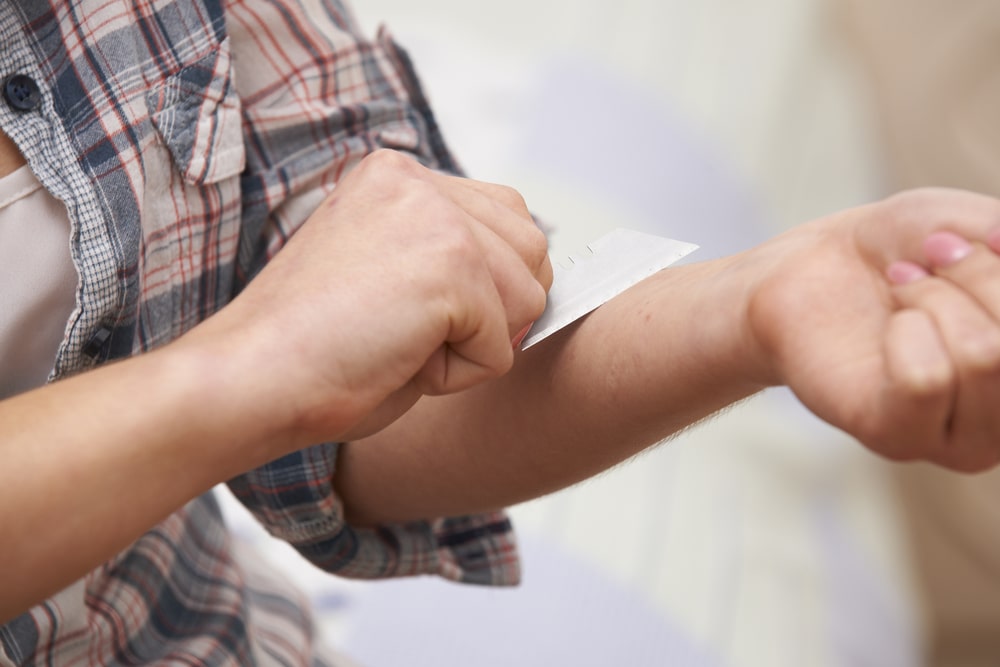Parents often worry about someone hurting their son or daughter. But when teenagers engage in acts of self-harm and hurt themselves, it can be overwhelming, confusing, and terrifying for their family and loved ones.
There are many reasons why children self-harm, and for most, self-harming behaviors are not attempts at suicide. However, self-harming behaviors can be indicative of depression in teenagers and young adults. Untreated depression and other mental health disorders can increase a teen’s risk of suicide and self-injury. It’s crucial that parents and guardians understand why kids self-harm, and where to turn to for help.
Discovering that your son or daughter is self-harming can be scary, but there are many ways that parents, guardians, and therapists can help teens cope with overwhelming emotions without resorting to hurting themselves. Today’s article will discuss why teens self-harm, what factors put them at risk for these behaviors, and what parents can do to get their child the help they need.

Why do people engage in self-harming behaviors?
People will engage in self-harming behaviors when they become overwhelmed with negative emotions and stress. Teens will self-injure to dissociate from tension or to distract themselves from emotional pain by replacing it with a tangible, visible and apparent physical pain.
Teenagers are at high risk for engaging in self-harming behaviors because they often do not have the emotional tools they need to cope with stressful situations and feelings safely. Often, those tools come with age and wisdom. It can be difficult for teens to fully process emotional pain and to make sense of it, which is why they may feel the urge to replace their emotional distress with something that is concrete and understandable to them, i.e., a physical cut or a burn.
In most cases, self-harm is not a cry for attention. Most teenagers are embarrassed or ashamed of their behavior after they commit an act of self-harm. Concealing self-harming behaviors and evidence is common, and it can be hard for parents to know something is wrong and subsequently intervene. Some of the most common reasons teens engage in self-injury include:
- As a way to alleviate their anxiety
- To reduce overwhelming feelings of sadness, loneliness, or alienation
- To relieve intense anger
- To punish themselves
- As a way to communicate their distress without words
- To feel something and escape emotional numbness
What self-harming behaviors are the most common among teenagers?
Self-harm among teens is more common than most parents would suspect. An estimated two million to three million U.S. adolescents hurt themselves on purpose to release negative, overwhelming emotions and shame. Unfortunately, those who practice self-harm often find themselves feeling guilty, and with low self-esteem after they self-harm. This leads to secretive behaviors and increases their chances of experiencing negative emotions in the future an engaging in more self-harming behaviors. The most common ways that teens self-injure include the following:
- Hitting
- Burning
- Scratching, picking, or excoriating wounds to keep them from healing
- Purposefully overdosing on medications, alcohol, or drugs
- Pulling out their hair, eyelashes, or eyebrows with the intention to cause themselves pain.
- Cutting
Who is most at-risk of engaging in self-harm?
Self-injury often starts in the early teen years, but anyone of any age, gender, ethnicity, or socio-economic status can self-harm. Teen girls are more likely to self-harm than boys.
Teenagers with symptoms of depression and anxiety are at higher-risk of self-harming than teens who do not suffer from these disorders. Also, teenagers with low-self esteem are also at-risk. Other risk factors include past and present abuse and neglect, bullying, death or a significant loss, and having an inability to cope with negative feelings in a positive way.
Teenagers who do not have a healthy relationship with an adult in their life may be at risk for self-harm. Having friends or family who engage in these behaviors, and also experiencing substance abuse or untreated mental health disorders can increase a teenager’s risk of engaging in non-suicidal self-injury.
In the past, non-suicidal self-injury was considered a sign of severe psychopathology. But current studies and research into this area have found that self-harm is generally used to cope with distressing emotions, and is not typically an indication of severe mental illness. However, untreated depression in teens is a significant risk factor for self-harming behaviors. Anger and mixed emotional states also put teens at risk of self-injury.
What are the signs and symptoms that a teenager is self-harming?
It can be challenging for parents and guardians to know if their child is self-harming because most teenagers will go to great lengths to conceal their behavior. However, these signs can indicate that an adolescent is hurting themselves:
- Unexplained cuts or burns on the person’s arms, legs, or stomach
- They begin wearing long sleeves and pants in weather where it would not be considered appropriate.
- If you find razor blades or other sharp objects on their person or in their belongings
- If they give a weak excuse or an evasive answer to questions about their injuries.
There are also many emotional warning signs that a person is injuring themselves. Those may include things like an inability to handle or express negative emotions in a healthy way. Symptoms of depression, anxiety, or substance abuse can also accompany signs of self-harm. It’s important for parents and guardians to intervene early, so self-harm doesn’t escalate to a permanent injury or a suicide attempt.
Change of daily habits, particularly where teenagers go and spend the most time, may also indicate self-harming behavior. Teenagers may choose to cut themselves, for example, in a bathroom because there is a lock on the door and evidence is easily cleaned. If a teenager exhibits any of the symptoms above and has begun spending longer periods behind a locked door, it could be time for an intervention.
Signs that teenagers struggle to process negative emotions through healthy coping mechanisms can also be signs of self-harm. Examples may include:
- Sudden anger with physical expressions, such as slamming doors.
- Quickly escalating conversations by yelling or shouting.
- Refusal to engage in conversation.
- Crying fits or other signs of emotional distress they refuse or are unable to discuss or explain.
What can parents do if their teen is self-harming?
It’s critical that parents understand that self-harming behaviors can become addictive and that teens need to have a way to form healthier coping mechanisms for negative emotions. Getting a teenager evaluated for a co-occurring mental health issue and reaching out to a therapist who is experienced with treating teenagers is critical to preventing self-harming behaviors from escalating. In therapy, teens can learn how to process their negative emotions and express them in healthy ways that don’t involve self-injury. Learning these coping mechanisms is a process, and change will not happen overnight. But therapy is a highly effective way to help teenagers heal from the trauma of self-harm.
Are you concerned that your teenager is hurting themselves? The mental health professionals and therapists at Mission Harbor Behavioral Health understand how difficult this is for your family. Our therapists and healthcare workers are experienced in helping teenagers overcome self-harming behavior and replace it with positive coping mechanisms. All calls and emails are confidential. Please contact us today to explore treatment options for your teen.
Are eating disorders considered self-harm?
It’s important to note that doctors also consider eating disorders, including anorexia, bulimia, and binge eating as forms of self-harm. Although these disorders have been traditionally treated as separate conditions, they are intrinsically linked to the same anxieties, fears, and pressures that often lead to other kinds of self-harm.
As with the list of behaviors above, those self-harming in regards to food will often hide their behavior. Parents should watch for sudden changes in weight, persistent sore throats, dislike of eating with company, and other signs of food-based self-harm. These actions can create serious health issues, often even faster than exterior self-harm behaviors like cutting or burning. It’s important for parents to take action quickly in these cases and seek self-harm treatment for teens as soon as possible. Effects of eating disorders include but at not limited to:

Co-occurring Conditions
As mentioned earlier, self-harm may appear in tandem with depression, anxiety, and other mental health conditions. The urge to self-harm is often tied to these conditions, and self-harm treatment for teens may yield better results when paired with additional mental health treatment for teens. Doctors specializing in co-occurring conditions can help families see the full picture and get to the roots of self-harming behaviors.
Conditions like depression and anxiety warrant specialized treatment that may simultaneously help reduce the urges and underlying motivation to self-harm. Although each treatment regimen is tailored to suit an individual patient, parents should be willing to consider therapies and medications including prescription drugs, CBT, DBT, and trauma therapy. Families may even be instrumental in a teen’s recovery as participants in family therapy sessions.
It’s important for teens displaying self-harming tendencies to be carefully assessed by experienced specialists who can identify potential contributing factors. Dual-diagnosis doctors and therapists can assist with substance abuse problems that fuel other self-harming habits. In the case of severe depression and/or anxiety, prescription medications and other therapies may help adjust brain chemistry.
Families must work together while pursuing mental health treatment for teens. Some studies show that mental illnesses like depression and anxiety may be inheritable. This makes parents’ honesty and dedication especially important as their own experiences and medical history can help their child and attending physician achieve the best possible results.
Are you looking for experienced specialists and Southern California rehab options? Our Southern California rehab center offers solutions for nearly every self-harming situation.
Updated content 12/23/2020
The facilities at Mission Harbor are staffed with trained experts to best assist patients with their mental health issues. We are capable of dealing with any and all cases with a licensed staff, equipment, and approved techniques. Our mission is to help those who want to help themselves, and we support your decision in seeking help.
Get Help Now
Alcohol addiction is extremely difficult to overcome on your own.. Seek specialized help and let professionals guide you in your recovery.

